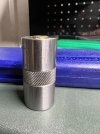I have a question about some of the NATO 7.62 brass I'm prepping for use.
About 10 years ago when I lived in South Carolina, I stocked up on used NATO 7.62 brass. Over the years, I've reloaded about 1k rounds for plinking and deer/hog hunting. None of these rounds were intended for long range use. I would resize and reload in the same sitting.
On Monday (1/23/23) I resized about 100 cases of PMJ 06' using my RCBS Rock Chucker Supreme with a RCBS .308 F L Die Set (P/N 15501). On every 10th case, I cycled in the chamber of a R700 .308 and in Wilson Case Gage. Each round fit perfectly in the Wilson Case Gage and cycled in the R700.
Last night (1/26/23), when prepping the mouths of the 100 cases, I noticed that while they cycle in the R700, they now do not fit as well in the Wilson Case Gage as they did 3 nights before.
In reading from several sources later last night and earlier today, I read about a few potential causes: ( 1 ) "rebounding" if I don't hold the cases for 5-6 seconds per cycle, and ( 2 ) the possible need for small base die.
I noticed a crack in the toggle block (replacements parts are on the way) so my Rock Chucker is currently disassembled and can't try resizing currently.
Anyone with experience reloading NATO 7.62 brass willing to chime in?
Thanks,
Scrmblr1982cj8

